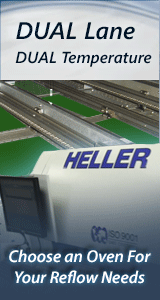Printed Circuit Board Assembly & PCB Design Forum
SMT electronics assembly manufacturing forum.
- SMTnet
- »
- Electronics Forum
- »
- Micro Solder Balls in No Clean Selective Solder Process
Micro Solder Balls in No Clean Selective Solder Process
Views: 7954
![]() We are building class 3 products, using no clean on wave and...
- Jan 08, 2008
by
Noid
We are building class 3 products, using no clean on wave and...
- Jan 08, 2008
by
Noid
![]()
![]() Mask finish is the #1 variable for micro-balling with wave a...
- Jan 09, 2008
by
Dirk Nuendyke
Mask finish is the #1 variable for micro-balling with wave a...
- Jan 09, 2008
by
Dirk Nuendyke
![]()
![]()
![]() Besides changing fluxes, do you have good knowledge of actua...
- Jan 09, 2008
by
mparker
Besides changing fluxes, do you have good knowledge of actua...
- Jan 09, 2008
by
mparker
![]()
![]()
![]() Hi its normally down to the state of cure of the resist type...
- Jan 14, 2008
by
BLT Circuit Services Ltd
Hi its normally down to the state of cure of the resist type...
- Jan 14, 2008
by
BLT Circuit Services Ltd
![]()
![]()
![]() Based on past, actual, hands-on experience, I have found tha...
- Jan 15, 2008
by
Dirk Nuendyke
Based on past, actual, hands-on experience, I have found tha...
- Jan 15, 2008
by
Dirk Nuendyke
![]()
![]()
![]() SORRY I did not offer a solution so here goes - The best way...
- Jan 15, 2008
by
BLT Circuit Services Ltd
SORRY I did not offer a solution so here goes - The best way...
- Jan 15, 2008
by
BLT Circuit Services Ltd
![]()
![]()
![]() Yes, the previous "non-balling" flux was alcohol based, but ...
- Jan 15, 2008
by
Dirk Nuendyke
Yes, the previous "non-balling" flux was alcohol based, but ...
- Jan 15, 2008
by
Dirk Nuendyke
![]()
![]()
![]() Yes, the mask finish is prolly the #1 contributor to solder ...
- Jan 15, 2008
by
Real Chunks
Yes, the mask finish is prolly the #1 contributor to solder ...
- Jan 15, 2008
by
Real Chunks
![]()
![]()
![]() Hi �Pb-Head�
I agree with everything you say, except for ...
- Jan 15, 2008
by
Patrick Bruneel
Hi �Pb-Head�
I agree with everything you say, except for ...
- Jan 15, 2008
by
Patrick Bruneel
![]()
![]()
![]() Patrick, you're right. I've only dealt with 2 different fla...
- Jan 15, 2008
by
Dirk Nuendyke
Patrick, you're right. I've only dealt with 2 different fla...
- Jan 15, 2008
by
Dirk Nuendyke
![]()
- SMTnet
- »
- Electronics Forum
- »
- Micro Solder Balls in No Clean Selective Solder Process







